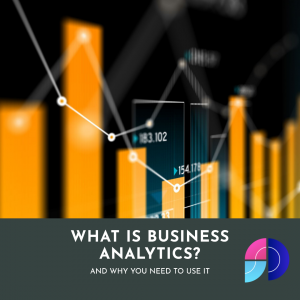What is Business Analytics?
Introduction:
What is Business Analytics and why use it?
Business analytics refers to the skills, technologies, and practices used to examine the data and performance of an organisation. It aims to generate insights that can help improve business performance and decision-making. Business analytics can help businesses understand their current situation. Predict future outcomes, and prescribe optimal actions.
Business analytics can be applied in different domains and industries. Such as marketing, finance, operations, human resources, and more.
For example, business analytics can help marketers segment customers, optimize campaigns, measure return on investment, and personalize offers.
Business analytics can help finance managers forecast revenues. They can also manage risks, allocate resources, and evaluate performance.
It can be used to help operations managers optimize processes, reduce waste, improve quality, and increase efficiency.
Business analytics can help human resources managers recruit talent, retain employees, enhance engagement, and develop skills.
These are just some of the examples of how business analytics can benefit businesses in various fields.
Types of Business Analytics
The three main types of business analytics are descriptive, predictive, and prescriptive. They answer different questions about business problems and provide different levels of insights.
Descriptive analytics
This type of business analytics answers the question of what happened in the past or what is happening in the present. It uses data to summarize, visualize, and report the current or historical state of a business. Descriptive analytics can help businesses understand their performance. Also to Identify trends, and monitor key performance indicators. Some examples of tools and techniques used for descriptive analytics are dashboards, charts, tables, and descriptive statistics.
Predictive analytics
This type of business analytics answers the question of what will happen in the future. It uses data to model, forecast, and estimate the future outcomes or probabilities of a business. Predictive analytics can help businesses anticipate changes, optimize decisions, and prepare for scenarios. Some examples of tools and techniques used for predictive analytics are regression, classification, clustering, and machine learning.
Prescriptive analytics
This type of business analytics answers the question of what should happen or what is the best course of action for a business. It uses data to optimize, recommend, and prescribe the best solutions or strategies for a business. Prescriptive analytics can help businesses achieve goals, improve efficiency, and increase effectiveness. Some examples of tools and techniques used for prescriptive analytics are optimization, simulation, decision analysis, and artificial intelligence.
Benefits of Business Analytics
Business analytics can offer many benefits for businesses, such as:
Increasing efficiency
Business analytics can help businesses optimize their processes, reduce waste, improve quality, and increase productivity. For example, Fitbit devices collect data on users’ activity and eating habits, and create dashboards that users can track through mobile apps.
Reducing costs
Business analytics can help businesses manage their resources, identify inefficiencies, and lower expenses. For example, looking at trading patterns by hourly buckets to determine optimum staffing levels
Enhancing customer satisfaction
Business analytics can help businesses understand their customers’ needs, preferences, and behaviour, and provide personalized and relevant products, services, and offers.
An example of this would be analysing baskets of goods. Looking for groups of products that are frequently purchased together. And recommending those items to the customer
Identifying opportunities
Business analytics can help businesses discover new markets, segments, products, and strategies, and test their viability and potential.
For example looking at best selling colour options for a category. Such as T Shirts, then making sure that those best selling colour options are available in the best selling styles
Mitigating risks
Business analytics can help businesses anticipate and prevent threats, uncertainties, and crises, and prepare contingency plans and solutions.
For example, looking at the ratio of sales across sizes in a product category. The risk of carrying too much stock in fringe sizes can be mitigated by weighting the purchasing more into the main sizes
These are just some of the examples of how business analytics can benefit businesses in various fields. Business analytics can help businesses make more informed and effective decisions, and achieve their goals and objectives.
Challenges of Business Analytics
Some of the main challenges of business analytics are:
Data quality
Data quality refers to the accuracy, completeness, consistency, and timeliness of data. Poor data quality can affect the validity and reliability of business analytics, leading to erroneous conclusions, misleading insights, and wrong decisions. Some of the causes of poor data quality are human errors, data entry errors, data duplication, data corruption, and data decay. Some of these can be accidental, some can be deliberate. Controlling data quality is vital to ensure trust
Rubbish in, Rubbish Out (to put it politely)
Data validation can help, along with data cleansing to reduce the risk of errors. Data deduplication is often necessary to eliminate repetition. Having good controls around standardisation and monitoring are essential.
Data security
Data security refers to the protection of data from unauthorized access, use, modification, or disclosure. Data security is crucial for maintaining the confidentiality, integrity, and availability of data. Data breaches can compromise the privacy and trust of customers, employees, and stakeholders, and result in legal, financial, and reputational damages. Some of the causes of data breaches are cyberattacks, insider threats, human errors, and natural disasters.
Data Security can be improved by restricting access, employing encryption. Having robust back up policies and procedures also helps to ensure security
Data privacy
Data privacy refers to the rights and obligations of individuals and organizations regarding the collection, use, sharing, and disposal of personal data.
Personal data is any information that can identify or relate to a specific individual. Such as name, email, phone number, location, health, and financial records. Data privacy is essential for respecting the autonomy, dignity, and preferences of data subjects, and complying with the relevant laws and regulations. Some of the causes of data privacy violations are lack of consent, lack of transparency, lack of accountability, and lack of compliance.
Methods to maintain data privacy include data anonymisation, minimisation, data retention and privacy policies
Data integration
The process of bringing together data from many systems, formats, and sources to a central point.
Data Integration simplifies data analytics throughout the entire organisation. Because of its variety, complexity, and volume, data integration can be difficult. Data silos, data inconsistency, data incompatibility, and data latency are a few of the factors that contribute to problems with data integration.
Data warehousing, data pipelines, data lakes, data virtualization, and data integration tools are a few methods or best practises that help with data integration
Data literacy
The ability to read, write, comprehend, and interact with data is referred to as data literacy. In order to maximise the value and effect of data analytics and to empower an organization’s data-driven culture and decision-making, data literacy is essential.
Low knowledge of data can result from a lack of expertise, understanding, self-assurance, and interest in data. Data resistance, data jargon, data overload, and data complexity are a few of the factors that contribute to gaps in data literacy. Data education, data coaching, data storytelling, data visualisation, and data collaboration are a few strategies or best practises to promote data literacy.
Data ethics
The principles and ideas that guide the ethical and responsible use of data are referred to as data ethics.
Data ethics can be ambiguous due to the diversity, uncertainty, and dynamism of data. Some of the causes of data ethics dilemmas are data bias, data discrimination, data manipulation, and data exploitation.
Some of the solutions or best practices to adhere to data ethics are data quality assurance, data impact assessment, data ethics framework, data ethics committee, and data ethics code
Looking for advice and support to get the value from your data?
Contact us for a FREE initial consultation



